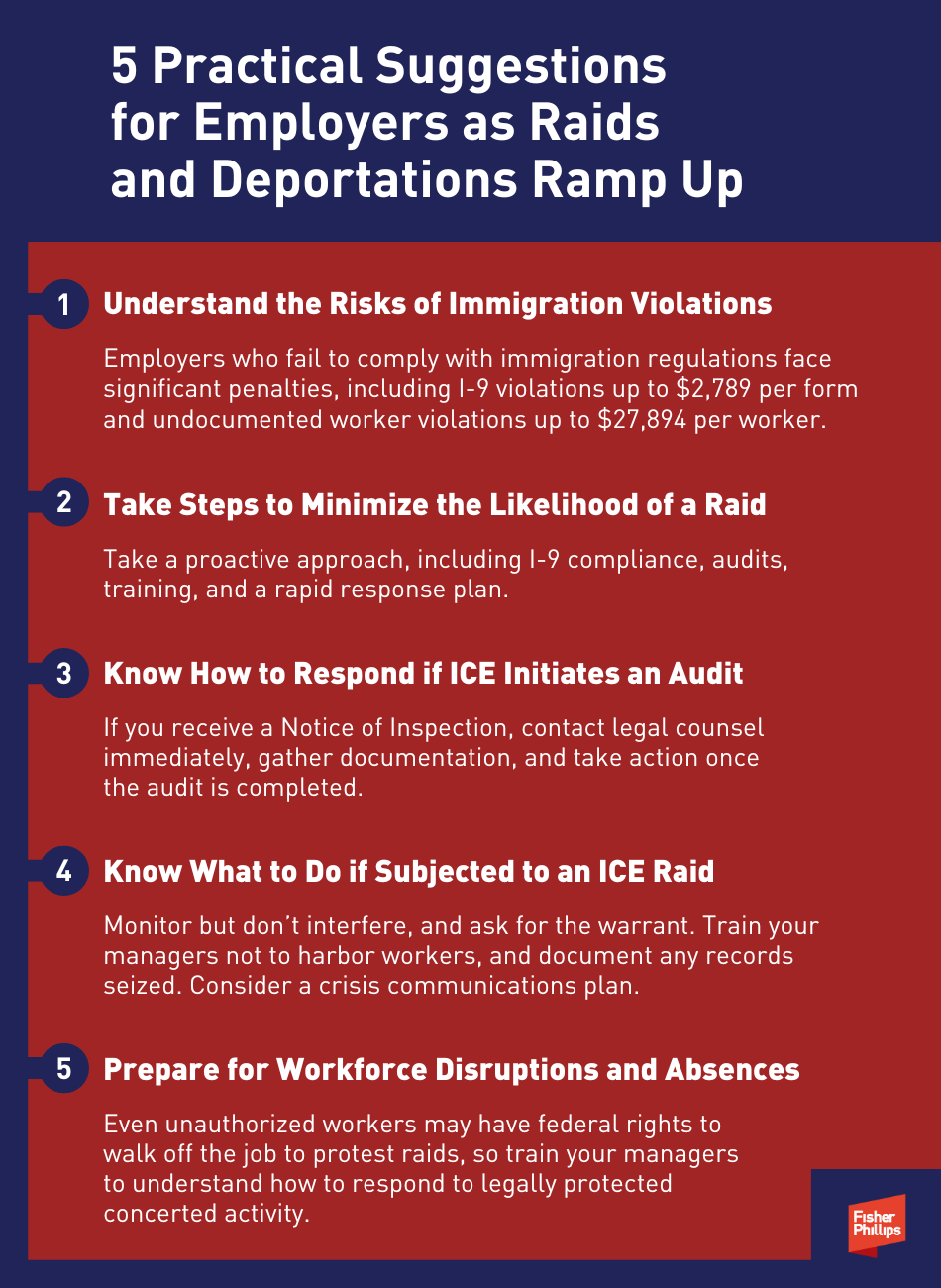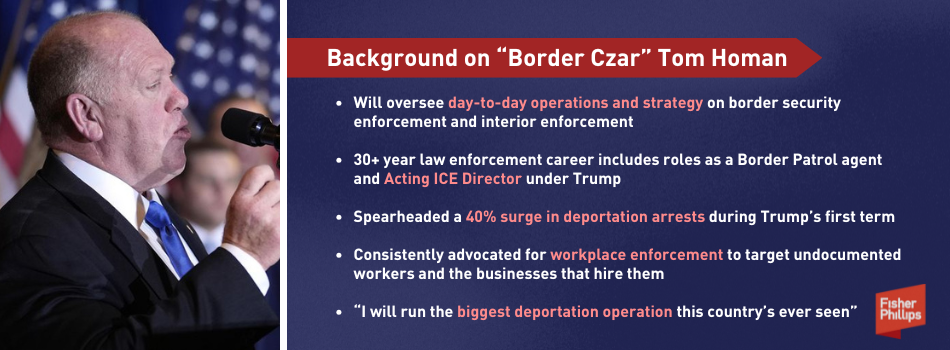Incoming Border Czar Signals Heightened Immigration Enforcement: 5 Steps for Employers to Prepare for Anticipated Raids and Deportations
Insights
11.14.24
President-elect Trump’s recent announcement that former ICE Acting Director Tom Homan would serve as the new “border czar” is yet another strong reminder that employers should anticipate a renewed focus on immigration enforcement when the new administration begins in January. With Homan’s strong track record of workplace enforcement, mass deportation plans, and a commitment to resuming large-scale worksite operations, now is the time for employers to act. You’ll want to spend the next two months reinforcing your compliance efforts, preparing for potential audits and raids, and implementing proactive steps to minimize disruptions. Here’s a breakdown of what employers need to know about Homan and practical measures to get ahead of anticipated enforcement.
Background: What to Expect from Tom Homan
- What is the “Border Czar?” It’s not an official government title, and it doesn’t require Senate confirmation – but the position wields tremendous power. It’s an informal designation that first arose in 1995 under President Clinton, used to describe an official tasked with overseeing and coordinating policies related to border security and immigration. Homan is expected to oversee day-to-day operations and strategy on both border security enforcement and interior enforcement.
- Extensive Enforcement Experience: Homan’s 30+ year law enforcement career includes roles as a Border Patrol agent and acting ICE director, where he helped oversee record deportation levels. He even held a key role at ICE under President Obama. Known for his no-nonsense approach, he has consistently emphasized strict immigration controls as a key component to national policy.
- Proponent of Aggressive Tactics: As one of the key architects of the “zero tolerance” policy, Homan’s tenure under the previous Trump administration included large-scale deportation efforts. Homan spearheaded a 40% surge in deportation arrests and established policies to make immigration arrests at courthouses, among other controversial policies. Expect more of the same in the second Trump administration. Speaking at a conference earlier this year about what would happen if Trump won reelection, Homan said, “I will run the biggest deportation operation this country’s ever seen.”
- Advocacy for Workplace Operations: Homan has consistently advocated for workplace enforcement to target undocumented workers and the businesses that hire them. He has stated that ICE will target public safety threats first – but will eventually pursue non-criminal, undocumented workers and the employers that harbor them. As he said earlier this year, “no one’s off the table. If you’re here illegally, you better be looking over your shoulder.”
- Policy Ties: Homan is listed as a contributor to the conservative “Project 2025” initiative, which outlines strict immigration policies and enforcement strategies. His alignment with this project underscores his commitment to reducing undocumented workers in the U.S. through measures like mandatory E-Verify and robust audit programs.

5 Practical Preparation Suggestions for Employers
With Homan set to lead an aggressive enforcement strategy, employers should take concrete steps to safeguard their operations and be prepared to handle potential ICE audits and raids. Below are key areas to focus on to ensure your business is ready.
1. Understand the Risks of Immigration Violations
Employers who fail to comply with immigration regulations face significant penalties, including:
- Civil Fines: Penalties for Form I-9 violations can reach up to $2,789 per form. Knowingly hiring undocumented workers can lead to fines of up to $5,579 for first offenses – but up to $27,894 per worker for repeat offenders.
- Criminal Penalties: Managers and business owners could face up to 10 years in prison and fines up to $250,000 for actions considered “harboring” or concealing undocumented workers. Upon conviction of any federal felony, the Criminal Asset Forfeiture statute allows a jury to authorize seizure of all assets used in the commission of the crime and all proceeds of the crime.
- Debarment from lucrative federal contracts: Pursuant to Executive Order, the President can instruct the federal government to not procure goods and services from an employer who violates the law.
- Operational Disruptions: ICE raids can halt business operations, damage morale, and lead to public relations issues, especially in industries like construction, agriculture, hospitality, and manufacturing, which often employ higher concentrations of undocumented workers.
2. Take Steps to Minimize the Likelihood of a Raid
A proactive approach is essential to reduce the chances of an ICE visit. Below are the core areas for compliance that employers should address immediately:
- Establish I-9 Compliance: Ensure every employee hired after November 6, 1986, has a complete and properly filled out Form I-9 on file. Use payroll records to verify that all required forms are on hand.
- Conduct Regular I-9 Audits: Regularly auditing I-9 forms is key to identifying and remedying any discrepancies. Working with outside counsel to conduct periodic, thorough audits will help ensure that your records are accurate and up to date.
- Employee Training: Train your managers and HR staff on how to complete I-9 forms, recognize document issues, and take appropriate action if they suspect an employee may lack proper work authorization.
- Consider Using E-Verify: Although not mandatory for all employers, using the E-Verify system can bolster compliance and demonstrate due diligence in verifying employee work eligibility – and perhaps even provide you a safe harbor or a ticket to reduced penalties if a violation is found.
- Establish a Rapid Response Plan: Designate a trained “raid team” to handle ICE visits, including contacting immigration and employment counsel, monitoring compliance with warrants, and tracking actions taken by ICE agents.
3. Know How to Respond if ICE Initiates an Audit
The most common way in which your business might end up interacting with enforcement officials is through an audit. An ICE audit, often initiated through a Notice of Inspection, requires employers to produce I-9 forms and additional records within three days. If your business receives such notice:
- Contact Legal Counsel Immediately: Your legal team can help you audit I-9s, make allowable corrections to minimize penalties and, if necessary, negotiate a short extension for gathering records. They can also work with ICE officials to streamline the audit process to keep ICE agents away from the worksite.
- Gather and Verify Documentation: Ensure all requested documents are organized and accurate. Along with I-9 forms, ICE may request payroll records, E-Verify confirmations, ownership information, agreements with staffing companies, and 1099s.
- Review Findings and Correct Errors: Once the audit concludes – which could take anywhere between two weeks and several years – ICE will inform you of any issues. The best news you can hope for would be a letter indicating that you are in full compliance. If the agency only finds minor technical or procedural violations, you will be allowed to correct them within 10 business days. More severe findings could lead to fines or warnings. Legal counsel can negotiate fines and advise on corrective actions.
If ICE identifies unauthorized workers, you’ll receive a notice of suspect documents, giving you a window to clarify or terminate the employment of any worker whose documentation does not meet standards.
4. Know What to Do if Subjected to an ICE Raid
Raids are highly disruptive, often involving immediate inspections and potential detentions. Follow these steps to stay compliant while minimizing operational risks:
- Request and Examine the Warrant: Verify the search warrant’s validity, ensuring it is signed by a judge. Immediately provide a copy to legal counsel. If ICE officials have a search warrant when they come knocking on your door, they will take the position that they are entitled to immediate access to your premises and records. There is no three-day period to gather documents, and ICE agents will not wait for your attorney to arrive before commencing their search.
- Monitor but Don’t Interfere: Assign a representative to observe and document ICE’s actions while maintaining a cooperative stance. Do not obstruct or engage in hostile actions, which could worsen legal outcomes.
- Avoid Actions that Could be Construed as Harboring: Instruct managers not to hide employees, shred documents, or provide false information. Employees should be free to speak to ICE agents if questioned but are not required to do so without legal counsel.
- Document and Report Seized Property or Records: Track all items and information taken by ICE and share this information with legal counsel immediately.
- Manage Public Relations: After a raid, determine whether a public statement is necessary and how best to communicate the event to maintain your business’s reputation. You should consider working with a crisis communications team to limit risks and minimize exposure.
5. Prepare for Workforce Disruptions and Absences
If fear of raids affects attendance, know that certain forms of collective action, including work stoppages, may be protected by the National Labor Relations Act (NLRA) – regardless of whether your workers are unionized. The NLRA generally comes into play when employees initiate action among coworkers over work-related issues or bring complaints about the workplace to management. These same protections have generally been extended to unauthorized workers.
Although you may have a legitimate interest in maintaining normal productivity levels under these circumstances, employees who choose not to report for duty may be deemed to be collectively refusing to work in protest of the raids, and therefore protected. Conversely, those who confine their protests to broad-based government action unrelated to workplace concerns are generally not afforded such protection.
Train managers to engage with employees in a neutral, supportive manner and avoid threatening discipline for legally protected concerted activity. Consider offering options for employees to discuss their concerns and encourage transparent communication to minimize potential work disruptions. Although you can instruct such employees that they will not be paid for time they spend off the job, make sure your managers know not to threaten or discipline anyone for engaging in lawful protests if they decide to walk out.
Finally, make sure to check any relevant collective bargaining agreements (CBAs) for provisions related to mandatory notice requirements when immigration issues arise, and to determine the full scope of information you must provide to your employees.
Conclusion
If you have any questions about these developments or how they may affect your business, please contact your Fisher Phillips attorney, the authors of this Insight, or any member of our Immigration Practice Group or our Labor Relations Practice Group. Visit our Election Season Resource Center for Employers to review all our thought leadership and practical resources, and make sure you are subscribed to Fisher Phillips’ Insight System to get the most up-to-date information.
Related People
-
- Shanon R. Stevenson
- Partner
-
- Todd A. Lyon
- Partner


